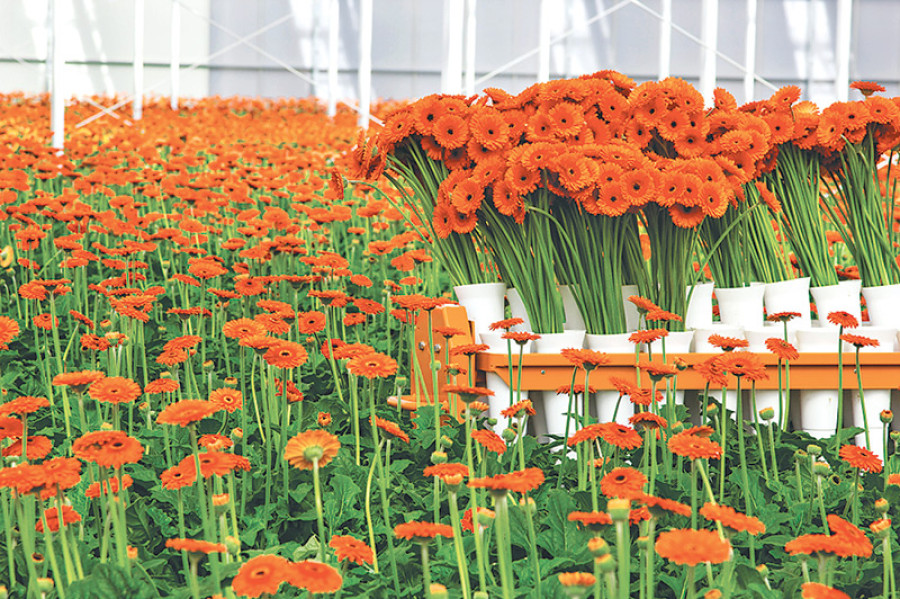Money
Floriculture business booms alongside rapid urbanisation
The floriculture business in Nepal is booming and becoming more innovative with urbanisation spreading rapidly over the last few years. Demand for flowers is traditionally high during festival season. Nowadays, middle-class people have started buying flowers to present as gifts during other special occasions.
Naresh Neupane
The floriculture business in Nepal is booming and becoming more innovative with urbanisation spreading rapidly over the last few years. Demand for flowers is traditionally high during festival season. Nowadays, middle-class people have started buying flowers to present as gifts during other special occasions.
In 2013-14, flower sales were recorded at Rs1.28 billion. The figure had surged to Rs1.71 billion in the last fiscal year. Traders said that there could be a double-digit jump in sales this fiscal year.
According to the Floriculture Association of Nepal (Fan), only 30 percent of the country’s flower requirement is imported.
The rise in domestic consumption has led flower traders to diversify into nursery-keeping, retailing and landscaping in urban areas. Innovative practices too have emerged in the floriculture business.
Compared to the limited variety of flowers available in the past, many hybridised variety of flowers are now grown and marketed in Nepal.

Rose, gladiolus, tuberose, gerbera, carnation and orchid were the popular flowers in
the market previously. Now, a large assortment of flowers are available.
Cut flowers and flowers grown in variously sized pots are sold in the market. Cut flowers are popular for decoration purposes in homes, offices, hotels and resorts. Urban and affluent individuals in particular also buy them to give as gifts during birthdays and marriages, retailers said.
In recent years, flower marketers have adopted new techniques with regard to pot flowers. “Previously, most pot flowers used to come in heavy earthen pots which take up a lot of space, but pot flowers now are light, take up little space and also
provide good blossoms,” said Dilip Bade, senior vice-president of Fan.
Ramesh Sanjel, owner of Sikha Nursery in Thapathali, said, “We mainly import seeds from foreign countries. However, we are relying on soilless materials to cover germinating seeds to prevent insects and other organisms from affecting growth.” “The market is also receptive to soilless structures as people tend to prefer light and small pot flowers.”
The floricultural business carries high risk as most flowers tend to shrivel and wilt after a few weeks even if they are put in cold storage. However, this business is also highly profitable if traders are aware of the market trends and demand. They should know the time when flowers are consumed in large quantities.
Along with cut and pot flowers, sales of flower bulbs are also increasing. A flower bulb has a short stem with a fleshy leaf or leaf bases. Flower bulbs of tulips, dahlias, gladiolas and lilies planted during the appropriate season takes several months to blossom.
Retailers believe that the trend of giving pot flowers as gifts has taken off among urban residents. Like cut flowers, pot flowers can be used to decorate houses, offices, hotels and resorts.
The most popular flowers sold in the market are marigold, gladiolus, rose, tuberose, carnation, gerbera and orchid. The daily demand for gladiolus, carnation and rose is 8,000-10,000 units each. Likewise, 4,500-7,500 units of tuberose and 1,000-3,000 units of orchid are sold daily.
Marigold is commercially grown in Nepal. According to Fan, 15,000-20,000 marigold garlands are sold daily during the festive season. Marigold sales, both in volume and value, have more than doubled in the last five years. Besides the Tihar festival, flower sales jump steeply during the week of Valentine Day on February 14.
Sujit Sasmal, a flower seller in Tripureshwor, said, “Consumers now increasingly prefer flowers in baskets. They like rose, gerbera and carnation in small and light baskets.”
Landscaping is also gaining popularity in the country. In the past years, landscaping was mostly confined to growing grasses. Nowadays, many individuals and corporate houses and hotels build miniature indoor waterfalls, fountains and gardens.
Despite innovation and increasing sales, the flower business faces various challenges. Flower growers are not able to meet domestic demand. Basanti Pradhan, CEO of Rudyn Agriflora Nepal, said, “Nepal can be self-sufficient in flowers in a few years if the government sets up floricultural labs and cold storage facilities. Modern instruments should also be used for harvesting, washing and drying flowers.”




 8.12°C Kathmandu
8.12°C Kathmandu













